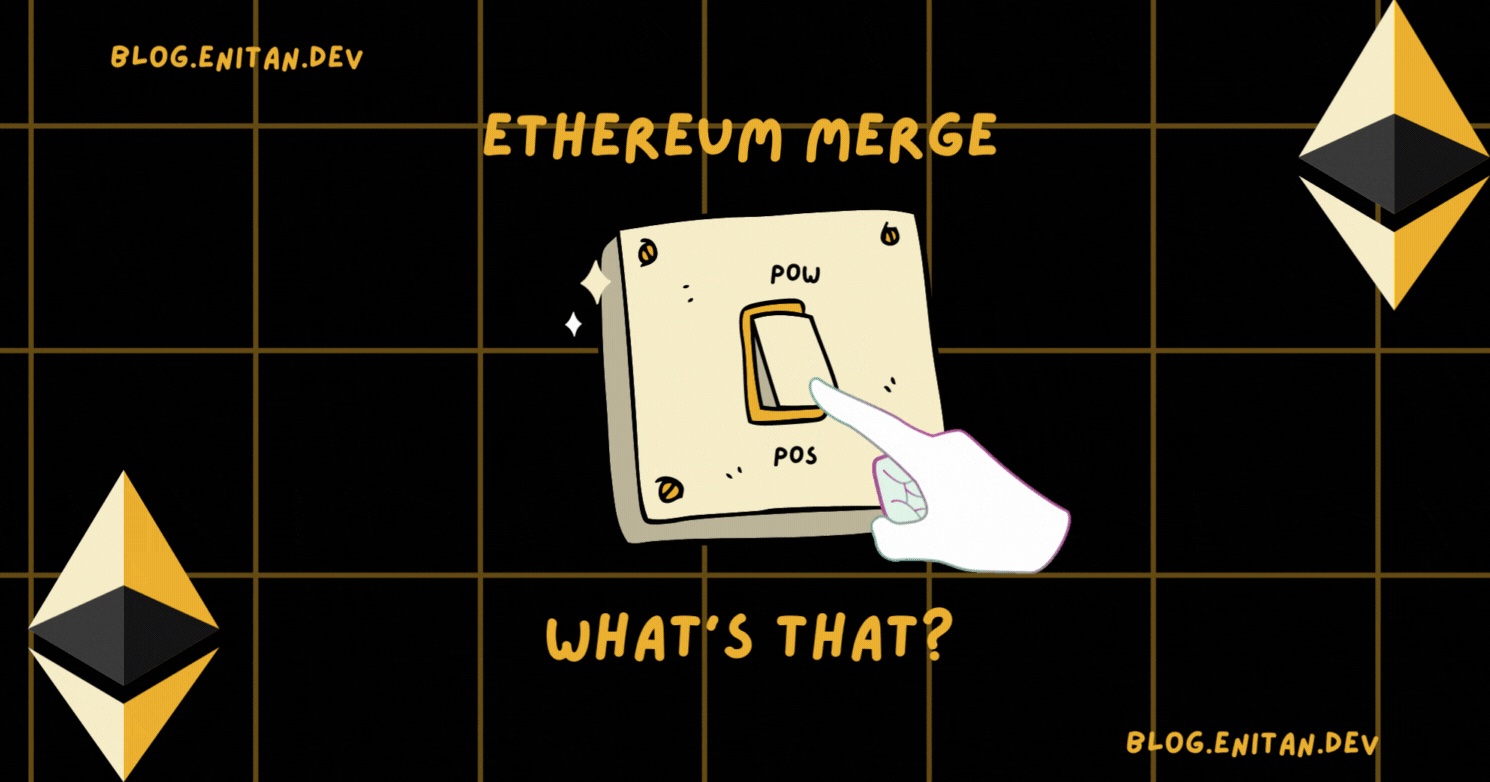The Ethereum Merge Explained
 Enitan Bello
Enitan BelloTable of contents
- What exactly is the Ethereum merger?
- What exactly is the purpose of a consensus mechanism?
- What's with the name "Merge" anyway?
- When exactly will the merge take place?
- The Merge has a chance of failing.
- Is proof-of-stake preferable to proof-of-work in this situation?
- Will anyone who uses Ethereum or holds ETH need to take any additional steps after the merge?

I believe that many people today are confused about the Ethereum Merge. Some are simply concerned with not being left out by following the trend.
If you fall into either of these two categories, I'm here to assist you.
Understand the concept of a merge before hyping the Ethereum merge all over your social media handles.
What exactly is the Ethereum merger?
The term "merge" refers to a shift in the Ethereum consensus mechanism from Proof of Work (POW) to Proof of Stake (POS).
If you're confused by some of the terms above, I've got you covered.
Let's take it one step at a time. We'll become acquainted with these terms;
- Consensus Mechanism
- Proof of Work (POW)
- Proof of Stake (POS)
The consensus mechanism denotes general agreement. Consensus is the broadcast that occurs when a block is added to the blockchain on nodes and is agreed upon by all nodes.
What exactly is the purpose of a consensus mechanism?
-To secure the network by making it difficult to breach. -To authenticate Blockchain transactions.
Proof of Work (POW) and Proof of Stake (POS) are both used in the blockchain network to confirm a transaction.
The role of miners in the blockchain network is represented by Proof of Work (POW). Before a transaction is carried out and added to a block from the mempool, it must pass through a series of checks to ensure its authenticity. Miners use a special hardware device to verify cryptocurrency transactions in a process known as mining.
Validators validate crypto transactions in Proof of Stake (POS). Validators are people who have a "stake" in the blockchain.
It's similar to having a large sum of money in a bank; the amount of money you own gives you a sort of right to make certain decisions on bank activities because you are a highly valued client.
You could storm the bank one day and complain about a particular banking service and be attended to right away because of the value of your bank account.
Both Proof Of Work (POW) and Proof Of Stake (POS) are decentralized mechanisms that are open-sourced.
Validators in proof of stake are chosen based on a set of rules based on their "stake" in the blockchain.
Miners validate transactions by solving cryptographic puzzles. The first miner to solve a puzzle receives the cryptocurrency. This was Ethereum's previous mechanism.
Validators with a minimum of 32 ether (equivalent to $50,000) staked on the network may be chosen to verify transactions with the upcoming Proof of Stake POS. The more ether you stake in the network, the more likely it is that you will be chosen to verify transactions.
Both mechanisms reward miners and validators with cryptocurrencies.
Now that we have the fundamentals covered, let's talk about a few other things.
What's with the name "Merge" anyway?
Although Ethereum already has a Proof-of-Stake network known as the Beacon Chain (which was launched in 2020), it is not yet being utilized for the processing of transactions. For the time being, it primarily serves as a holding area for the preparation of the Proof of Stake upgrade by the computers that run the Ethereum network. In order to complete the transition from PoW to PoS, Ethereum's Beacon Chain (also known as the "Consensus" layer) must be merged with Ethereum's mainnet (also known as the "Execution" layer).
When exactly will the merge take place?
Around the 15th of September in 2022. That's 3 days from now
Why is there no firm deadline? On the Proof-of-Work network that Ethereum uses, every block carries a difficulty number that indicates how much work miners need to put in to add it to the network. Instead of taking effect at a predetermined date, the merge is slated to go into motion once the total terminal difficulty, which is calculated by adding up the difficulties of all of the Ethereum blocks that have been mined, reaches a certain threshold (TTD).
The Merge has a chance of failing.
Yes, but it's highly unlikely.
The switch from proof-of-work to proof-of-stake that Ethereum is planning to implement will be the first experiment of its kind. In the event that the merge is successful, this will be a significant achievement in the fields of engineering and human coordination. In the event that it is unsuccessful, it runs the risk of erasing hundreds of billions of dollars' worth of value (the current market cap of Ether is close to $200 billion, and many other valuable tokens are built on top of the network). The Merge is only moving forward at this point because its core developers and other stakeholders have completed more than a dozen successful tests and simulations of the Merge (see: shadow forks and testnet Merges). There is still a remote possibility that the merge will not be successful, despite the fact that this outcome appears to be extremely improbable.
Is proof-of-stake preferable to proof-of-work in this situation?
There are pros and cons to consider.
The Ethereum Foundation, a nonprofit organization that provides funding for the development of the Ethereum ecosystem, estimates that Proof of Stake will reduce Ethereum's energy consumption by approximately 99.95 percent. In addition, proponents of proof-of-stake argue that proof-of-work mining concentrates power in the hands of those who have the financial means to purchase expensive cryptocurrency mining rigs. They claim that because Proof of Stake (PoS) gives control of the network to those who "stake" crypto with the network, attacks become economically unfeasible and ultimately fruitless. In response, proponents of proof-of-work argue that proof-of-stake mining comes with its own set of centralization and security risks, making it possible for malicious actors to "buy" control of the network directly. In addition to this, they highlight the fact that PoS is a less battle-tested system than PoW, which has shown itself to be resilient as the backbone of the two largest blockchain networks.
Will anyone who uses Ethereum or holds ETH need to take any additional steps after the merge?
No!
If you currently possess ether (ETH), you will not be required to claim new "PoS ETH" or "ETH2" tokens in the future. After the merge, your balance will be unaffected in any way, and you will be able to continue using the network as if nothing had transpired in the interim. In the event of the Merge, users of Ethereum will not be required to take any action. However, Ethereum software providers and node operators (the computers that operate the Ethereum network) will be required to update their software in order to ensure that they are communicating with the most recent version of the network.
I hope you found this article useful. Leave a comment, like and share if you did.
Subscribe to my newsletter
Read articles from Enitan Bello directly inside your inbox. Subscribe to the newsletter, and don't miss out.
Written by

Enitan Bello
Enitan Bello
I am a developer who loves to write about code and other technical stuff